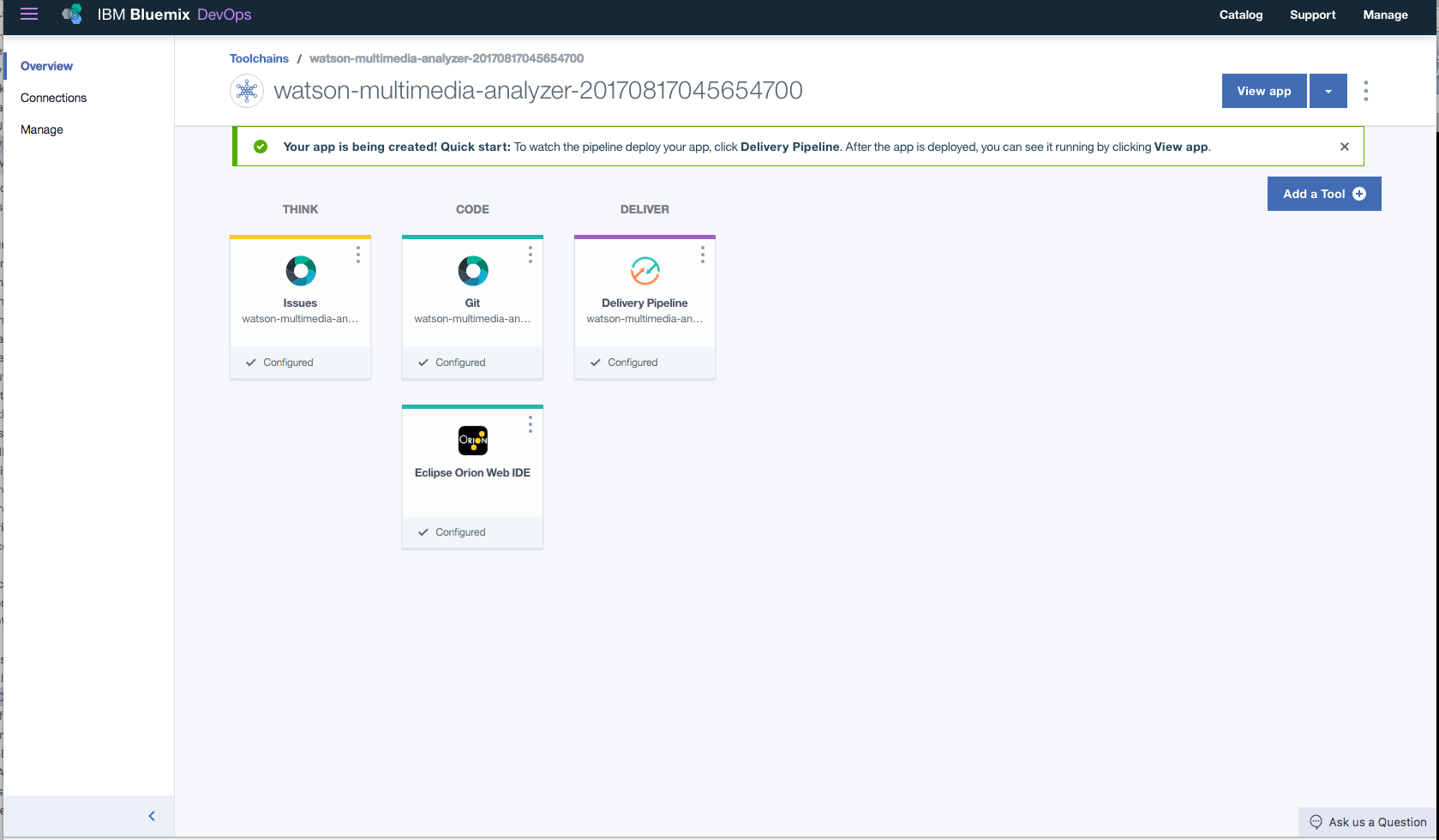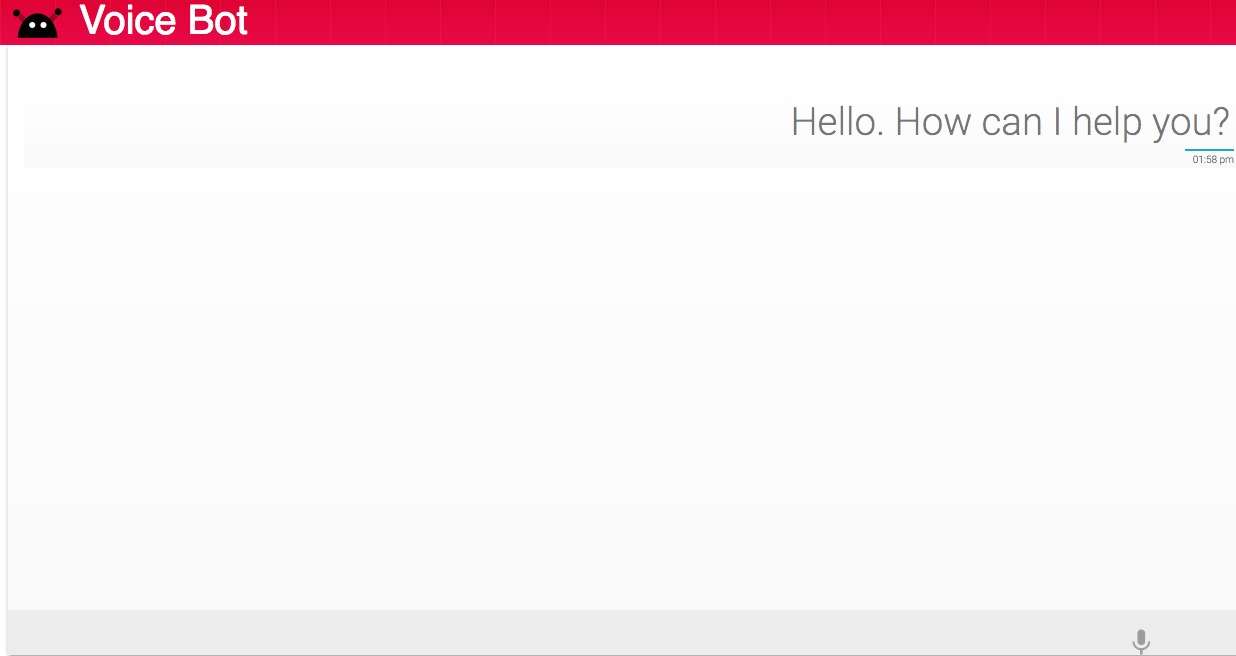In this code pattern we will create a web based chat bot, but the twist here is that we'll be using voice input and output. For the conversation dialog we'll of course be using Watson Assistant, but we'll also be using Watson Speech To Text to capture the user's voice, and lastly we'll use Watson Text To Speech to playback the chatbots response to the user. The web application itself is built on top of JQuery and Python Flask.
When the reader has completed this code pattern they will understand how to:
- Make a Watson Speech To Text call using a Web Socket Connection
- Make a Watson Text to Speech REST API call
- Send and receive messages to Watson Assistant using REST APIs
- Integrate Watson Speech To Text, Watson Text To Speech and Watson Assistant in a web app
- User selects the microphone option on the browser and speaks.
- The voice is passed on to Watson Speech To Text using a Web Socket connection.
- The text from Watson Speech to Text is extracted and sent as input to Watson Assistant.
- The response from Watson Assistant is passed onto Watson Text to Speech.
- The audio output is sent to the web application and played back to the user, while the UI also displays the same text.
- Watson Speech-to-Text: A service that converts human voice into written text.
- Watson Text-to-Speech: Converts written text into natural sounding audio in a variety of languages and voices.
- Watson Assistant: Create a chatbot with a program that conducts a conversation via auditory or textual methods.
- Flask: Python is a programming language that lets you work more quickly and integrate your systems more effectively.
- jQuery: It is a cross-platform JavaScript library designed to simplify the client-side scripting of HTML.
We'll have two methods to run this application: using an easy one-click deploy option, or locally with a few CLI tools. Depending on your objective, learning or seeing the app quickly, choose accordingly.
If you prefer to deploy the application manually, scroll down to the next section.
Steps:
- Clone the repo
- Create the services and deploy the web app
- Upload the Watson Assistant workspace
- Configure environment variables
Clone the watson-voice-bot repo locally. In a terminal, run:
git clone https://github.com/IBM/watson-voice-bot
We’ll be using the file data/workspace.json.
The next step is to deploy the application, we'll do this by clicking the button below. A nice byproduct of doing this is that the services required (Speech-to-Text, Text-to-Speech, and Assistant) will be created automatically. Click the button below.
When the DevOps Toolchain Pipeline appears, click on the Deploy button to start the deployment. You can optionally, click on the Delivery Pipeline to watch the logs as the app is deployed.
Once deployed, the app can be viewed by clicking View app. The app can also be viewed in the dashboard. The app should be prefixed with the string watson-voice-bot-, and the corresponding services that were created can easily be identified by the wvb- prefix, i.e.: wvb-assistant.
Now that our services are created and the app is deployed we need to update the application to use a specific Watson Assistant dialog. We'll be using the file data/workspace.json, which documents our entire conversation dialog. To do this, launch the Watson Assistant tool and use the import icon button on the right. Find the data/workspace.json file from the cloned repo and import that to the Watson Assistant tool.
Each workspace in Watson Assistant has a specific ID. To find the Workspace ID for a given workspace, click the context menu of the workspace and select View details. The workspace ID can be copied and saved as we'll need it in the next step.
Optionally, to view the conversation dialog select the workspace and choose the Dialog tab. Here's a snippet of the dialog:
The last step to perform is to configure our application to use the right Watson Assistant dialog. We'll solve this by specifying the workspace ID as an environment variable that the web application has access to read. To do this we'll navigate to our application overview from the IBM Cloud Dashboard, searching for watson-voice-bot and clicking on the name.
From the application overview, we can click on the Runtime menu located in the navigation bar on the left. Select the Environment Variables tab. Scroll down and click on Add.
We'll add the environment variable key name as WORKSPACEID and for the value we'll use the workspace ID from Step 3. Click Save and wait for the application to reload.
Once the application restarts, click on the generated URL and start interacting with your voice enabled chatbot! See Sample output for things to say to your chatbot.
- Clone the repo
- Create Watson services with IBM Cloud
- Upload the Watson Assistant workspace
- Configure
.envwith credentials
Clone the watson-voice-bot repo locally. In a terminal, run:
git clone https://github.com/IBM/watson-voice-bot
We’ll be using the file data/workspace.json.
Create the following services:
Now that our services are created and the app is deployed we need to update the application to use a specific Watson Assistant dialog. We'll be using the file data/workspace.json, which documents our entire conversation dialog. To do this, launch the Watson Assistant tool and use the import icon button on the right. Find the data/workspace.json file from the cloned repo and import that to the Watson Assistant tool.
Each workspace in Watson Assistant has a specific ID. To find the Workspace ID for a given workspace, click the context menu of the workspace and select View details. The workspace ID can be copied and saved as we'll need it in the next step.
Optionally, to view the conversation dialog select the workspace and choose the Dialog tab. Here's a snippet of the dialog:
Our services are created and workspace uploaded. It's now time to let our application run locally and to do that we'll configure a simple text file with the values we want to use. We begin by copying the the env.sample file and naming it .env.
cp env.sample .env
We now populate the key-value pairs with credentials for each IBM Cloud service (Assistant, Speech To Text, and Text To Speech). These values can be found in the Services menu in IBM Cloud, by selecting the Service Credentials option for each service.
Lastly, the WORKSPACEID value was retrieved in the previous step, we use that value here.
# Replace the credentials here with your own.
# Rename this file to .env before starting the app.
# Watson Assistant
WORKSPACE_ID=<add_assistant_workspace>
ASSISTANT_URL=<add_assistant_url>
## Un-comment and use either username+password or IAM apikey.
# ASSISTANT_USERNAME=<add_assistant_username>
# ASSISTANT_PASSWORD=<add_assistant_password>
# ASSISTANT_IAM_APIKEY=<add_assistant_apikey>
# Watson Speech To Text
SPEECHTOTEXT_USER=<add_stt_username>
SPEECHTOTEXT_PASSWORD=<add stt password>
# Watson Text To SpeechToText
TEXTTOSPEECH_USER=<add tts username>
TEXTTOSPEECH_PASSWORD=<add tts password>
- Start the app by running
python welcome.py - Launch a browser and navigate to http://localhost:5000
- Click on the microphone icon to begin speaking and click it again when you are finished.
Follow the script below for a sample path in an insurance domain, or configure your own dialog under Watson Assistant.
Voice Bot: Hello. How can I help you?
User Reply: I am trying to buy an insurance
Voice Bot: You have come to the right place We offer you a smart, affordable and convenient way to safeguard the future for you and your family. Can I ask you a couple of questions to come up with the best plan for you?
User Reply: ok sure
Voice Bot: Please tell me your Name followed by Date Of Birth and Annual Income
User Reply: This is Mary
Voice Bot: Please enter your Date of Birth
User Reply: 2nd June 1945
Voice Bot: Your annual income?
User Reply: 1200000 dollars
Voice Bot: Do you smoke?
User Reply: Nope I dont
Voice Bot: Please tell me your gender
User Reply: Female
Voice Bot: Enter a protection type
Select one among Basic Life Cover, Fixed Income Protection or Increasing Income Protection.
User Reply: Life Cover
Voice Bot: What premium payment frequency would you prefer? Monthly, Quarterly, Half Yearly or Yearly?
User Reply: Monthly
Voice Bot: What term would you want to go for? Enter a range between 10 years to 35 years.
User Reply: 8 years
Voice Bot: Please enter a term ranging between 10 years to 35 years.
User Reply: 12
Voice Bot: Your yearly premium for 12 years under the Basic Life Cover plan is 67767 dollars. Do you want to try any other options or go ahead with buying this?
User Reply: No What is Basic Life Cover?
Voice Bot: On death during the Policy term, Sum Assured as a lump sum is paid to the nominee and the policy terminates.
User Reply: ok Thanks
Voice Bot: Have a great day
- Artificial Intelligence Code Patterns: Enjoyed this Code Pattern? Check out our other AI Code Patterns.
- AI and Data Code Pattern Playlist: Bookmark our playlist with all of our Code Pattern videos
- With Watson: Want to take your Watson app to the next level? Looking to utilize Watson Brand assets? Join the With Watson program to leverage exclusive brand, marketing, and tech resources to amplify and accelerate your Watson embedded commercial solution.
This code pattern is licensed under the Apache Software License, Version 2. Separate third party code objects invoked within this code pattern are licensed by their respective providers pursuant to their own separate licenses. Contributions are subject to the Developer Certificate of Origin, Version 1.1 (DCO) and the Apache Software License, Version 2.





